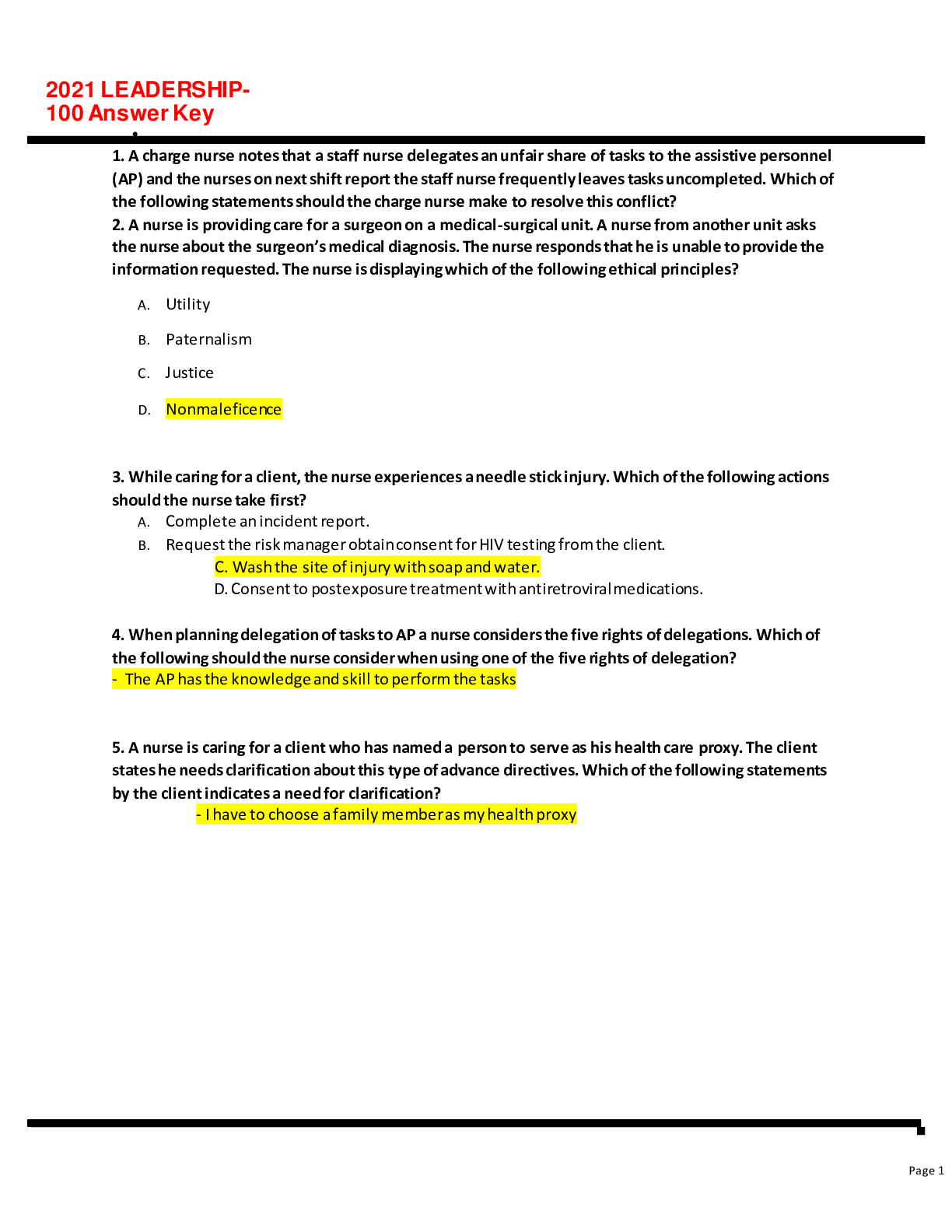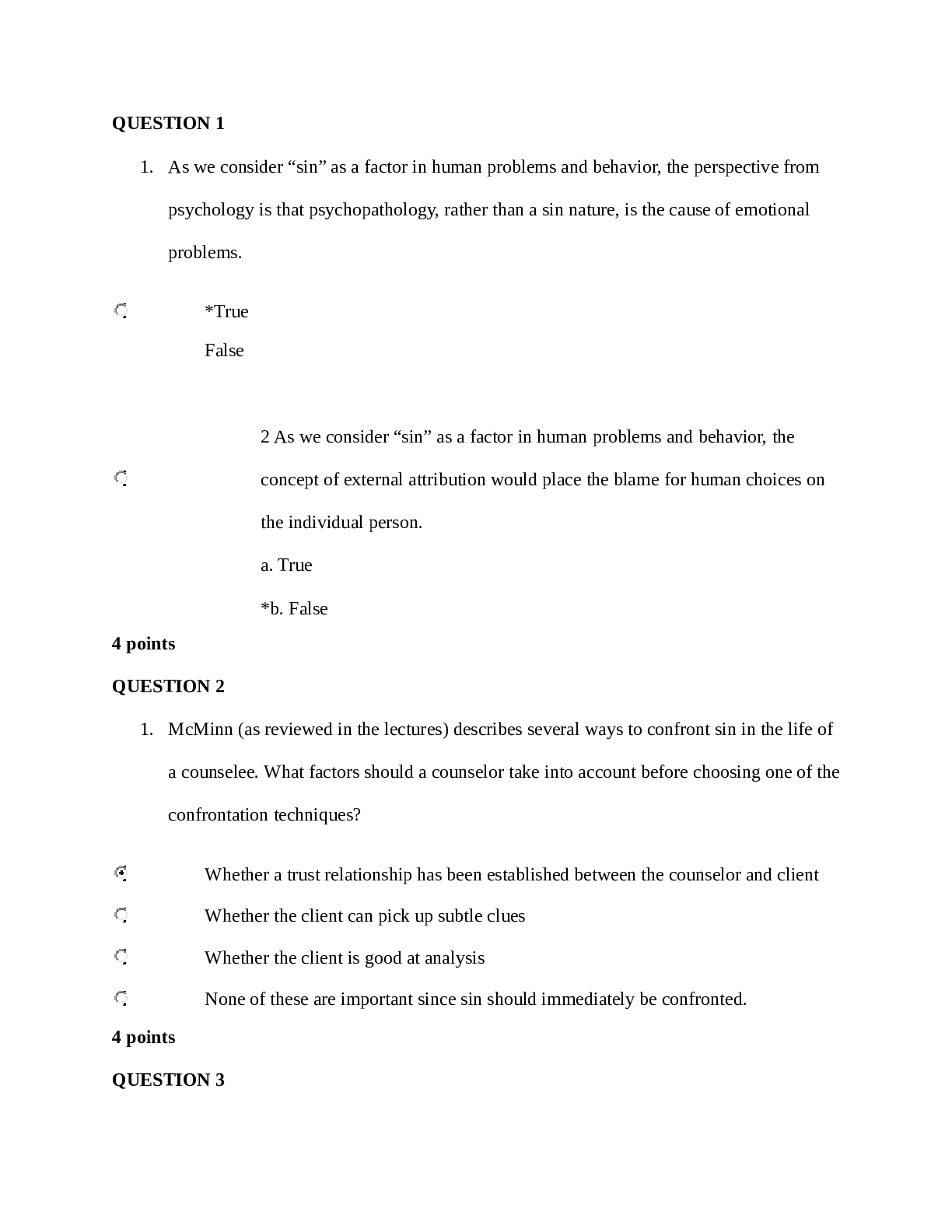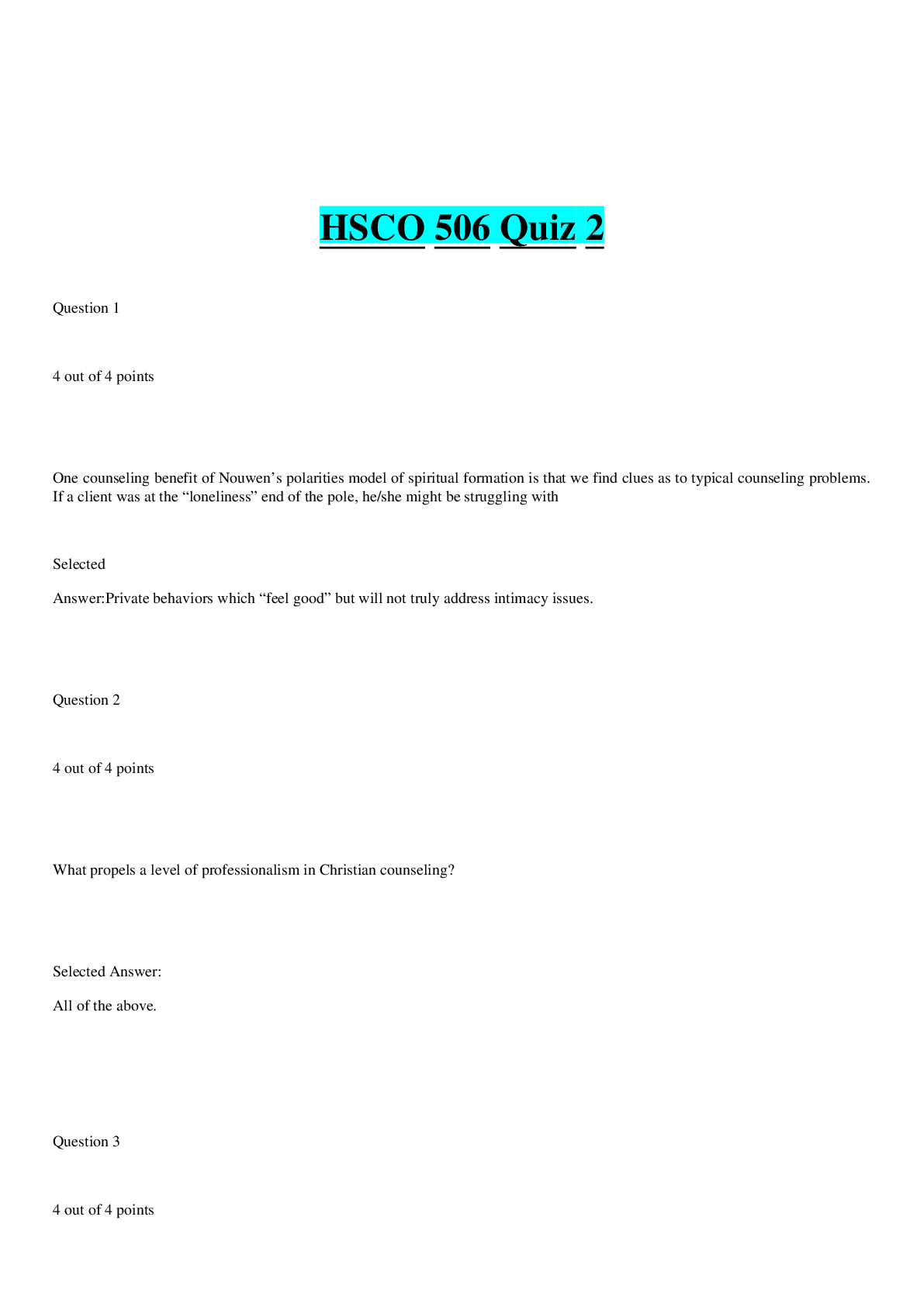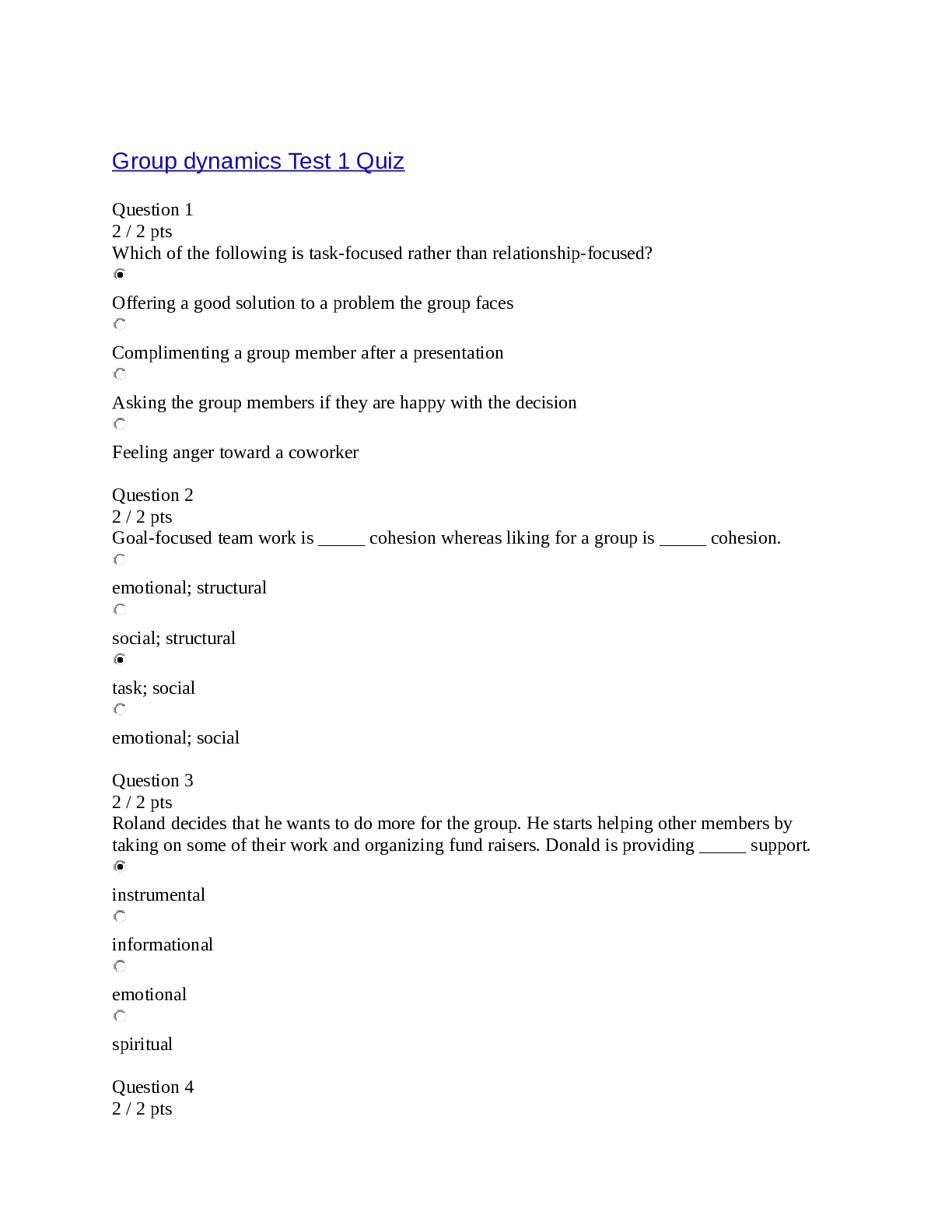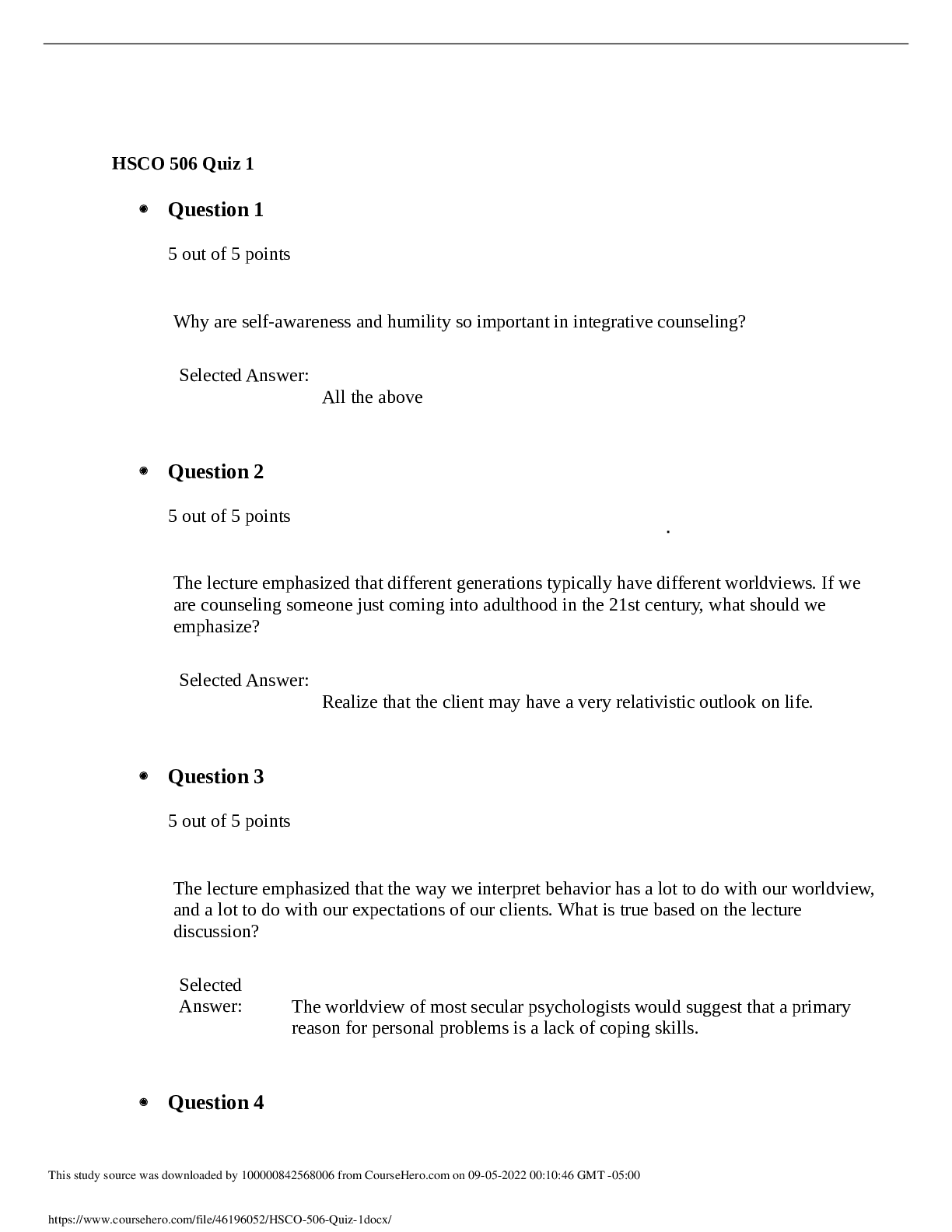*NURSING > QUESTIONS & ANSWERS > Kaplan University > NURSING > HA 515 Quiz 3 Leadership Chapters (UPDATED 2020) (15, 16, 17, 18) (100 (All)
Kaplan University > NURSING > HA 515 Quiz 3 Leadership Chapters (UPDATED 2020) (15, 16, 17, 18) (100% CORRECT ANSWERS)
Document Content and Description Below
Quiz 3 Leadership Chapters (15, 16, 17, 18) Chapter 15: The Health Care Organization and Patterns of Nursing Care Delivery MULTIPLE CHOICE 1. How does managed care affect the economics of health ca... re delivery? a. Provides incentives for smaller private or individual hospitals b. Increases the tax bases for the community c. Uses corporate economics to achieve a profit d. Decreases duplicate processes and redundant facilities 2. Which statement regarding characteristics of clinical pathways shows the nurses understanding? a. “Clinical pathways focus on patient outcomes.” b. “Clinical pathways use a timeline with sequenced interventions.” c. “Clinical pathways collaborate efforts by health care professionals.” d. “Clinical pathways involve nurse-centered orientation.” 3. Which statement shows the nurses understanding of patient-focused care? a. “Patient-focused care is a nursing care delivery system.” b. “Patient-focused care is a model for a health care organization.” c. “Patient-focused care is a clinical pathway within an institution.” d. “Patient-focused care is an institutional value and philosophy.” 4. Which statement by the nurse manager is accurate regarding case management? The two tools that support case management are a. “clinical pathways and patient classifications.” b. “clinically oriented and business-oriented pathways.” c. “clinical pathways and disease management protocols.” d. “centralized and decentralized system models.” 5. A nurse manager is training a new hire. Which statement shows an understanding of functional nursing? a. “Functional nursing is organized around tasks.” b. “Functional nursing is patient led.” c. “Functional nurses is physician led.” d. “Functional nursing is unorganized.” 6. Which of the following statements shows the nurses understanding of primary nursing? a. “Primary nursing involves planning and directing of patient care over 24 hours.” b. “Primary nursing involves care for 48 hours or more.” c. “Primary nursing involves one nurse planning care for the patient.” d. “Primary nursing is the only method of care used today.” 7. Which statement is true about case management? a. There are two models—traditional and full immersion. b. It is used to reduce resource utilization only. c. To be effective, it requires case managers to provide direct patient care. d. It eliminates the need for other caregivers (LPN, LVNs, nursing assistants). 8. A nurse is interested in case management. Which statement indicates an understanding of the primary work environment of case manager? a. “They work most often in acute care institutions.” b. “Their work is focused on community activities and is based within the community.” c. “They typically work for insurance companies, providing coordination of care.” d. “All types of health care organizations, as well as organizations with health-related functions, hire case managers.” 9. Which statement is true about patient classification systems? a. They measure all the needs of patients. b. They provide an absolute formula for unit staffing. c. They should not be used to make patient care assignments because acuity systems are more accurate. d. They provide historical data of the usage of nursing time, which is helpful when developing the department budget. 10. Which of the following best describes the concept of evidence-based practice? a. It is a method of improving nursing care and effectively maintaining cost containment. b. Insurance companies review the evidence of the health care practice for reimbursement. c. It achieves large-scale economics while providing cost-effective care. d. It provides for the use of recent research in current nursing practice. 11. A female patient is admitted to the labor and delivery unit, where she is assigned a registered nurse who will manage her care for the duration of her hospitalization. What type of nursing care delivery model is represented in this nursing unit? a. Functional care c. Patient-focused care b. Primary care d. Case management 12. The nurse is reviewing upcoming discharges. Which patient would a case manager be assigned to? a. A 55-year-old woman post hysterectomy, who has adequate support from family b. A 42-year-old man post appendectomy, who is able to change his own dressing c. A 60-year-old man post sepsis, in need of nursing home placement d. A 38-year-old woman, post shoulder repair, who needs to follow up with the orthopedic surgeon 13. Which action by the case manager would be required under the full immersion model? a. The case manager would see only the patients with the most extensive health care needs. b. The case manager would see all patients that come into the hospital. c. The case manager would only see the patients with health insurance. d. The case manager would conduct a daily chart review of patients he or she is assigned to. 14. Which of the following statements about evidence-based practice shows that the nurse has an adequate understanding? a. “Evidence-based practice is the hospital’s protocol for providing care.” b. “Evidence-based practice is based on community need.” c. “Evidence-based practice is a set of guidelines determined by each hospital unit.” d. “Evidence-based practice is the use of current best evidence in making decisions about patient care.” 15. A new nurse is determining which hospital to apply for. The nurse has heard a lot about magnet hospitals from friends that are nurses and knows that working for a magnet hospital would mean a. the nurse would likely experience high job satisfaction. b. the nurse would likely experience poor job satisfaction. c. the nurse would have to have a BSN before being able to apply. d. the nurse would be hired after having a year of nursing experience. 16. A nurse is covering for a coworker who is on a lunch break. While administering medications, the nurse notices a bag of antibiotic hanging with another patient’s name on it. The nurse immediately stops the infusion. What should the next step be? a. Say nothing about the error because the patient is fine. b. Speak with the coworker about the error and fill out the proper paperwork for documentation. c. Tell the other coworkers about the error. d. Tell the patient about the error. 17. The nurse assesses the quality of patient care to be higher in the Total Patient Care model because: a. Patients are able to perform the majority of their own care. b. Nurses are required to perform less care. c. Nurses are able to focus all of their care on one patient. d. Nurses are hired to care for two patients. 18. A nurse has been assigned as team leader for the day and is working with two LPNs and two unlicensed personnel. What should the nurse do to ensure success in caring for patients? a. Give the assignments for the day out to the team and plan to meet right before the end of shift. b. Continuously communicate with the members of the team throughout the entire day. c. Report changes in a patient’s condition to the health care provider only. d. Revise each patient’s plan of care once a shift. 19. The nurse has an adequate understanding of patient-focused care when stating which of the following? a. “Patient-focused care includes the physician, who supervises care.” b. “Patient-focused care decreases productivity.” c. “In patient-focused care, the nurse supervises delivery of care.” d. “The patient is not an active participant in patient-focused care.” MULTIPLE RESPONSE 1. Which type of nursing delivery models would be appropriate in a rural area that would require fewer numbers of registered nurses? (Select all that apply.) a. Functional nursing b. Team nursing c. Primary care nursing d. Patient-focused care e. Transitional care , B, D 2. The nurse understands cost containment when stating which of the following? Major elements of the law that support cost containment include (Select all that apply.) a. “increased governmental regulation of insurers.” b. “less use of technology.” c. “increasing incentives for coordination of care.” d. “emphasis on physician centered care.” e. “decreasing consumer out of pocket costs.” , C 3. Which action can the hospital administrator take to reduce health care costs? (Select all that apply.) a. Hire case managers to see all patients who have extensive medical needs. b. Reduce the number of patients the hospital can accommodate. c. Ensure that appropriate staff is available. d. Encourage the use of evidence-based practice. e. Accept only patients with health insurance. , C, D 4. Which statement by the nurse indicates understanding of the case manager’s role? The case manager (Select all that apply.) a. “guides patients through the health care delivery process.” b. “ensures quicker discharge for patients without insurance.” c. “coordinates care for the patient.” d. “assists patients in achieving goals effectively and efficiently.” e. “collaborates with the health care team.” , C, D, E 5. The nurse judges that the disease management program has been successful when the patient (Select all that apply.) a. assumes responsibility for their own health. b. learns how to maintain good health. c. can state how to manage their chronic condition. d. relies on the health care team for maintenance of health. e. can state how to avoid worsening of health. , B, C, E 6. The nursing shortage is projected to reach 1.2 million by 2020. Which actions can hospitals take to retain nurses? (Select all that apply.) a. Create a health care system that supports nursing advancement. b. Encourage a work environment that fosters workgroup cohesion. c. Allow nurses to have autonomy. d. Reduce the number of managers within the health care system. e. Allow nurses a variety of specialties to choose from. , B, C, E Chapter 16: Economics of the Health Care Delivery System MULTIPLE CHOICE 1. Which statement by the nurse indicates understanding of the major factors influencing the increase in health care costs? a. “Health care expenditures are exceeding the cost of the gross domestic product (GDP) in excess of 14%.” b. “Older adult patients consume more of the health care product than they can afford to finance.” c. “The cost of prescription drugs is soaring so rapidly that the majority of people cannot afford them.” d. “Because of the limited payment of Medicare, institutions are not being reimbursed at the same level of expenditures.” 2. A nurse is educating a coworker on the intrinsic factors and cost of health care. The nurse knows that the teaching has been effective when the coworker lists the following intrinsic factor as the major cause of increased cost: a. Almost 10% of Americans over 65 years old are considered at or below the poverty level. b. The new medical technology available has increased the cost of health care. c. There are increasing labor costs in the total hospital spending budget. d. The staff nurse does not understand the responsibility of economics and money management. 3. A nurse manager is preparing a presentation on health care economics for unit staff. How would the nurse manager explain the definition of economics as it relates to health care to the staff? a. Economics refers to how the health care system is going to care for the older segment of the population. b. Health care is a limited resource; economics refers to how this resource is going to be allocated. c. Health care economics refers to the budgeting and financial management of the institution providing the care. d. Economics is the balance of the utilization of health care services and the monies obtained for the services provided. 4. The nurse would identify which of the following as an example of a strategy that represents fiscally responsible clinical nursing practice? a. Begin discharge planning as soon as it is evident when a patient will be discharged. b. Encourage patients to consider being admitted the evening before a major surgical procedure. c. Use unlicensed personnel as much as possible in the delivery of nursing care. d. Accurately document the current status of a patient with regard to the patient’s ongoing needs. 5. The nurse manager receives the budget variance report for the assigned nursing unit. What other critical information must the nurse manager consider to evaluate this report? a. Projection of costs in the operating budget b. The amount of money allocated to meet expected costs c. Figures on which a zero-based budget were determined d. Planning needs for unit staffing based on patient acuity 6. Which statement by the nurse shows understanding of the Rand Health Insurance Experiment? a. “When consumers were required to pay 25% co-payment, there was a considerable decline in the use of health care services.” b. “There was an increase in the use of health care services when consumers were required to make a co-payment.” c. “If the health care cost is being paid by insurance companies, the consumer is not concerned about the cost.” d. “The implementation of the Oregon Health Policy for reimbursement of the cost of health care services led to the Rand Health Insurance Experiment.” 7. What is the nurse’s fiscal responsibility to the patient? a. To provide the best health care that the patient can afford b. To provide the best health care that the insurance company will allow c. To use the most cost-efficient resources to provide maximum health care to the patient d. To use the most efficient method of providing nursing care to patients whose resources are limited 8. What is the most important way that a nurse can be fiscally responsible to the employing institution? a. By providing quality, safe nursing care b. By considering patient needs and prioritizing appropriately c. By accurately documenting the patient’s condition d. By maintaining accurate charges for supplies used in patient care 9. Which statement is true about patient classification systems? a. The systems measure all the needs of patients. b. The systems provide an absolute formula for unit staffing. c. The systems should not be used to make patient care assignments because acuity systems are more accurate. d. The systems provide historical data of the usage of nursing time, which is helpful when developing the department budget. 10. The case manager is educating the nurse about health care costs. The case manager knows that the education has been effective when the nurse states: a. “Health care costs are increasing because demand is decreasing.” b. “Health care costs are steadily decreasing.” c. “The aging population is requiring more health care services, causing the costs to increase.” d. “The aging population is requiring less health care services, causing the costs to decrease.” 11. A nurse is educating a group of students about health care economics. Which statement would the students make if the teaching were effective? a. “Extrinsic factors include the cost of prescription drugs.” b. “Extrinsic factors include the age of the population.” c. “Extrinsic factors include the demand for health care.” d. Extrinsic factors include employer-paid health insurance.” 12. To provide quality care, the Affordable Care Act of 2010 a. reduced the number of patients accepted into Medicaid. b. kept the Medicaid system the same. c. made changes to slow growth in spending. d. increased Medicaid spending to ensure adequate patient care. 13. What action can nurses take to be fiscally responsible? a. Give patients their discharge instructions and let them determine if the cost of their medications fit into their budget. b. Allow nurses to work on the unit when the census drops. c. Use proper hand hygiene. d. Document minimally on each patient. 14. A case manager is educating a patient on health care insurance. Which statement by the patient shows that the teaching has been effective? a. “All health care is covered by insurance.” b. “Insurance does not cover inpatient hospital stays.” c. “All health care coverage is the same.” d. All health insurance companies have rules about what services will be covered.” 15. The nurse has an adequate understanding of capital budget when stating: a. “A capital budget is part of the expected expenses of the unit.” b. “A capital budget is used to purchase or replace equipment costing more than $5000.” c. “A capital budget is used to pay for nurses to work in the hospital.” d. “A capital budget is used to purchase lunch for employees.” 16. The nurse has an adequate understanding of productive time when stating: a. “Productive time is the amount of time the nurse is available to give care to patients.” b. “Productive time is the amount of time the nurse is attending a continuing education activity.” c. “Productive time is counted when the nurse is not directly giving bedside care, such as going to lunch and taking a break.” d. “Productive time is counted when the physician is at the patient’s bedside.” 17. Which of the following statements indicates the nurse’s understanding of fiscal responsibility? a. “Fiscal responsibility should be a concern for all nurses.” b. “Fiscal responsibility is only a concern for the department manager.” c. “Fiscal responsibility is only a concern for the hospital administrators.” d. “Fiscal responsibility is not a concern for the nursing staff.” 18. Which statement by the nurse is accurate regarding the current health care American’s receive? a. “The distribution of services is efficient across the population.” b. “The distribution of care is even across the population.” c. “Access to care related to income is improving.” d. “Many Americans receive care that causes harm.” MULTIPLE RESPONSE 1. It is important for the nurse to understand strategies that promote a fiscally responsible clinical practice. From the following listing, select those strategies that would achieve a fiscally responsible clinical practice. (Select all that apply.) a. Completes charge slips or scans bar code of nursing supplies used when changing a surgical dressing b. Participates in the annual hospital fund-raising activity c. Visits the Centers for Medicare & Medicaid Services to understand what services are provided during an inpatient visit d. Immediately reports any development of a patient medical complication to the health care provider e. Volunteers to participate in a hospital program initiative to reduce central line associated bloodstream infection (CLABSI) f. Completes a patient’s discharge plan on the morning of discharge , C, D, E 2. Which action by the nurse demonstrates fiscal responsibility to the patient? (Select all that apply.) a. Discharging a patient home with prescriptions and no health insurance to cover the cost b. Assessing the patient’s resources and determining their ability to pay for prescriptions c. Setting the patient up for Meals on Wheels d. Giving the patient information on free support groups e. Calling local churches to see what services they can offer the patient , C, D, E 3. Which action by the nurse shows fiscal responsibility to the employing organization? (Select all that apply.) a. Wash hands after each patient contact. b. Turn patients every 2 hours. c. Round on patients. d. Toilet patients frequently to prevent falls. e. Use resources of the institution wisely. , B, D, E 4. Which action by the nurse demonstrates fiscal responsibility to the employing organization? (Select all that apply.) a. Only bringing needed supplies into a patient’s room b. Accurately documenting the patient’s condition c. Minimally documenting in the patient’s chart d. Taking breaks as scheduled e. Remaining healthy and able to function on the job , B, D, E 5. Which action by the nurse shows fiscal responsibility to the payer of care? (Select all that apply.) a. Understand Medicare and Medicaid insurance coverage. b. Efficiently and effectively use resources to provide patient care. c. Document minimally in the patient chart. d. Select interventions which are cost effective. e. Document the patient’s plan of care. , B, D, E 6. A new graduate is preparing for a job interview. Which questions would be appropriate to ask the manager in regards to health care economics? (Select all that apply.) a. How is the acuity of patients factored into staffing? b. What is the turnover rate on this unit? c. How long are the breaks for staff on this unit? d. What is the overtime rate on this unit? e. What are the budgeted hours per patient day on this unit? , B, D, E Chapter 17: Political Action in Nursing MULTIPLE CHOICE 1. The state nurses association writes a new version of the Nurse Practice Act, secures a sponsor in the legislature, and lobbies legislators to adopt the bill. Which of the laws of power would the nurse label this situation? a. Power is invariably personal. b. Power invariably fills any vacuum. c. Power is exercised through and depends on institutions. d. Power is best exercised via large financial donations to individual legislators. 2. A nurse plans to lobby a state senator regarding a particular health care bill. Which action would be appropriate? a. The nurse should be specific about what action the senator should take early in the contact or letter. b. The nurse should tell the senator that if their advice is followed, the nurse will vote for the senator. c. The nurse should use a form letter to express personal opinion and encourage as many as possible to mail in the form letter. d. The nurse should avoid making contact by phone and only submit personal views in writing. 3. The clinical nurse leader makes out the daily assignments. One staff nurse tells another, “Last week I was asked to change my days off so the clinical nurse leader could go to a play in another city. I told the clinical nurse leader I couldn’t do it. Ever since then, I’ve been given the most difficult patients on the unit for my assignment.” The staff nurse can label this type of power as: a. Inherent c. Legitimate b. Referent d. Expert 4. The nurses at Community General Hospital are concerned about violence involving children in their community. They wish to propose to the city government that drug-free and weapons-free zones and corridors be instituted near each school. The nurses send liaisons to the city school board and the parent–teachers association to ask them to join the effort. What is the term for this type of strategy? a. Forming a coalition c. Collective bargaining b. Displaying legitimate power d. Seeking compromise 5. Which strategy is least effective in formulating political action? a. Ability to communicate information in concise terms b. Living and practicing in several different states c. Determining who should be contacted and for what political action d. Having the ability to use different channels of information 6. A nurse has recently moved from one state to another and wishes to write lawmakers to urge them to vote against a change in the Nurse Practice Act that would replace individual licensure with institutional licensure. What lawmakers should the nurse contact? a. The city council members b. The county (parish) legislators c. The state legislators from the district d. The federal legislators from the district 7. What is an example of the weakest source of power? a. Several nursing students talk with a head nurse regarding a problem they are having on the unit. The head nurse then discusses this problem with the chief nursing officer. b. The clinical nursing instructor sends a student to the skills lab for further practice. c. A nurse shares knowledge regarding nursing in a confident manner and style. d. The head nurse tells staff members that as soon as all the care plans are completed, they may have some additional compensation time. 8. Which statement by the nurse educator is accurate regarding politics? a. “Politics involves influencing the allocation of scarce resources.” b. “Politics involves identifying those in a public office that can be influenced.” c. “Politics involves attempting to get people in government positions to think the way you want them to.” d. “Politics involves lobbying for state and federal legislation to improve the quality of nursing care.” 9. Which statement by the nurse would best represent the purpose of a political action committee (PAC)? a. A vehicle for nurses across the country to organize collectively to endorse and support candidates for national offices b. A group of individuals or organizations who share a common interest in a single issue c. An organizational structure established for the purpose of supporting and fostering changes in the health care system d. A group that identifies special needs and raises funds to influence politicians to vote in a manner that supports the special needs 10. One of the five laws of power is that “power fills a vacuum.” Which statement by the nurse best captures that type of power? a. “An individual who provides leadership and power to create a strategy that will address a problem and get people to contribute to the effort” b. “People who are willing to give power to someone in order to restore comfort or handle a dilemma” c. “An individual who takes action to speak and act on behalf of a group d. A state nursing association that acts on behalf of the nurses within the respective state” 11. How would a nurse determine the political views regarding health care issues of individuals who are running for public office? a. Call the state or national political action committee of the American Nurses Association. b. Talk with the administration of the institution to determine who is supporting health care issues. c. Call the party headquarters of the candidates and ask them to share the views of the candidate with you. d. Call the Accreditation Commission for Education in Nursing (ACEN) and obtain the political action reports. 12. A nurse is educating a group of students about reward power. The nurse knows the teaching has been effective when one of the students says: a. “Reward power does not actually exist anymore.” b. “Reward power may cause a person to behave in a manner that benefits someone else.” c. “Nurses are not susceptible to reward power.” d. “Reward power only benefits nurses.” 13. What action should the student nurse taken to begin networking? a. Begin networking shortly after starting a new job. b. Avoid networking and establish a career based on reputation. c. Begin networking upon graduation. d. Begin the networking process when a new position is needed. 14. A group of nurses are concerned about access to health care in rural communities. Which action should they take to voice their concerns? a. Complain to their coworkers. b. Form a coalition to be combat the issue. c. Independently discuss the issues with other staff. d. Attend monthly staff meetings. 15. A nurse is actively involved in the political arena and is educating a colleague about becoming involved in the election process. The nurse knows that their teaching has been effective when a colleague states: a. “Nurses are discouraged from becoming involved in politics.” b. “The election process has nothing to do with nursing.” c. “It is easy for a nurse to become involved in the election process.” d. “Political campaigns never need any help.” 16. How does the Political Action Committee support candidates? a. “Buys” a candidate b. Lobby’s elected officials c. Evaluates candidates on nursing and health concerns only d. Does not endorse candidates for public office 17. Which of the following statements by the nurse shows understanding of the competence framework? a. “Competence development is the means by which the nurse gains knowledge, skills, and abilities.” b. “Competence development is the means by which the nurse’s knowledge, skills, and abilities are tested.” c. “Competence development refers to health and conduct expectations of the nurse.” d. “Competence development refers to the nurse’s ability to perform the functions of the nursing role.” 18. Which statement would be accurate of nurses who support collective bargaining? a. “Collective bargaining has set nursing back.” b. “In general, collective bargaining is ineffective.” c. “Collective bargaining forces positive change in the practice setting.” d. “Collective bargaining forces negative change in the practice setting.” MULTIPLE RESPONSE 1. What actions can nurses take that would demonstrate the skills necessary to move a vision? (Select all that apply.) a. Elect decision makers. b. Refrain from political involvement. c. Testify before legislative committee hearings. d. Compromise. e. Become elected officials. , C, D, E 2. What action makes up a nurse’s political savvy? (Select all that apply.) a. Analyzing a situation b. Participating in a constructive way c. Following directions d. Voicing an opinion e. Presenting a possible resolution , B, D, E 3. The nurse understands the importance of participation in politics when stating which of the following? (Select all that apply.) a. “It is important for nursing to be presented in a positive light.” b. “Nurses should fight for better health care for all patients.” c. “Nurses should only worry about what is occurring where they practice nursing.” d. “Nurses should lobby for the availability of health care.” e. “The public should see what nurses really do.” , B, D, E 4. The nurse has an adequate understanding of power when listing which of the following as laws of power? (Select all that apply.) a. Power invariably fills any vacuum. b. Power is invariably public. c. Power is based on a system of ideas and philosophy. d. Power is exercised through and depends on institutions. e. Power is invariably confront with and acts in the presence of a field of responsibility. , C, D, E 5. In what ways can the nurse lobby? (Select all that apply.) a. Upon meeting the candidate for the first time and assessing knowledge b. Meet face-to-face with the candidate to discuss the issues. c. The nurse cannot lobby a candidate. d. Write a letter to the candidate. e. Email the candidate. , B, D, E 6. A nurse is educating coworkers on power. The nurse knows the teaching has been effective when the coworkers state: The sources of power are (Select all that apply.) a. reward b. coercive c. punishment d. expert e. legitimate f. referent , D, E, F 7. A nurse has just moved to a new state and wants to know the names of the state senator(s), state representative(s), federal senator(s), and federal representative(s). How can the nurse find this information? a. Call the Democratic Party headquarters. b. Call the Republican Party headquarters. c. Call the public library. d. Call the local newspaper. e. Call Congress. , B, C MATCHING Identify the type of power base associated with each of the following. a. Joining a coalition to lobby for a national health insurance plan b. Organizing nurses to work for the opponent in the next election c. The dean of the school discussing the educational program d. Testifying before a committee on a bill e. A political action committee’s endorsement or financial contribution 1. Reward 2. Coercive (punishment) 3. Expert (informational) 4. Legitimate 5. Referent (mentor) Chapter 18: Collective Bargaining: Traditional (Union) and Nontraditional Approaches MULTIPLE CHOICE 1. Which statement best describes when collective bargaining by nurses can occur? a. Only when the nurses in the group are members of a union b. Whenever nurses see a need to organize to take collective action c. Only when the state nurses association is willing to represent nurses at a specific agency d. Whenever the state nurses association agrees that both wages and working conditions are inappropriate 2. In which situation would the traditional type of collective bargaining (union) help nurses attain their goals? a. Management has agreed to no nursing layoffs for one year after reorganization. b. Nursing has received a 4% salary increase this year and next year. c. Nurses have identified workplace safety issues and health hazards. d. Management has arranged for nurse practitioners to have admitting privileges. 3. Which provision—if labor management included it in a contract—would not be to nursing’s advantage? a. A workforce retraining provision b. Seniority rights c. A grievance procedure d. Wage adjustments based on bed occupancy 4. What would the nurse identify as a primary difference between traditional and nontraditional collective bargaining? a. Traditional collective bargaining is not organized through the state nursing association. b. Traditional collective bargaining units are organized and members belong to the National Nurses United. c. Nontraditional collective bargaining units are not recognized by health care organizations as a collective bargaining agency. d. Nontraditional collective bargaining has a long history and is based on the support of organizations throughout the country. 5. The nurse believes that an adequate understanding of arbitration through the traditional collective bargaining unit has been obtained. Which of the following statements supports this belief? a. “Arbitration is a management technique to discharge an employee.” b. “Arbitration is useful to resolve conflicts having a basis in the labor-management” contract. c. “Arbitration is always used before the formal grievance process.” d. “Arbitration is a process used to establish nursing standards.” 6. A staff nurse is scheduled to work 3 to 11 pm in the cardiac step-down unit. The staff nurse realizes they are the only RN that will be on duty. The staff nurse calls the supervisor to say that help will be needed. The supervisor replies that there are no available nurses to assign to this unit. What should the nurse do? a. Leave and go home rather than assume this responsibility. b. Protect themself by filing a written objection to the assignment. c. Call a temporary agency and arrange for coverage by a registered nurse. d. Call the state health department to investigate the staffing issue. 7. A nurse is preparing a presentation. How can the nurse explain one of the primary concerns of the proponents for a nontraditional collective bargaining unit versus the traditional, union-based nursing model? a. “The traditional-based union model frequently puts nurses and employers in adversarial positions.” b. “The union dictates to members what they can and cannot do within the health care institution.” c. “The union-based model can initiate strikes that can be detrimental to the provision of health care in an institution.” d. “The union-based model is too expensive and nurses are not fairly compensated by the organization.” 8. A nurse is giving a lecture on the primary problem that decreases the power of both types of collective bargaining models. The nurse knows that the teaching has been effective when a colleague states: a. “The small number of states that recognize either type of collective bargaining” b. “The political influences of the American Hospital Association on nursing organizations” c. “The adversarial goals of each of the respective organizations or models” d. “The lack of membership of the majority of practicing nurses” 9. A nurse is educating coworkers on the establishment of collective bargaining. The nurse knows the teaching has been successful when a coworker states: a. “Collective bargaining is still not recognized by hospitals.” b. “Nurse activists believed in a unified voice for nurses.” c. “Nurse activists wanted to option of working more hours.” d. “Collective bargaining is not effective.” 10. A charge nurse is providing education to coworkers on state nursing associations. The charge nurse judges that the teaching has been effective when a coworker states: a. “These professional associations address nursing practice.” b. “These professional associations do nothing to support nursing.” c. “These professional associations protect the rights of physicians.” d. “These professional associations are managed by hospital administrators.” 11. A union nurse is educating a new nurse on common issues faced by nurses today. The union nurse knows that the teaching has been effective when the new nurse states: a. “There are no common issues; nurses faces different issues based on their job.” b. “Today, there are no issues because of the advancement of technology.” c. “Hospitals are fully staffed at all times.” d. “Hospitals frequently mandated nurses due to staffing shortages.” 12. Which statement by the nurse indicates understanding of collective bargaining in the workplace? a. “Collective bargaining is not useful in the workplace.” b. “Collective bargaining is used by nurses to control their practice.” c. “Collective bargaining is used by managers to control nurses.” d. “Collective bargaining is always an adversarial process in the workplace.” 13. A nurse is discussing personal seniority with the department manager. The nurse has an adequate understanding of seniority when stating which of the following? a. “Seniority provides certain rights to those with the highest number of years of service” b. “Seniority provides the same amount of vacation time as new hires” c. “Seniority no longer provides protection in today’s economy” d. “Seniority means that those with the highest number of years of service can be forced to retire” 14. A nurse is educating a new nurse on grievance mechanisms. The nurse judges that the teaching has been effective when the new nurse states: a. “Nurses should attend any meeting where they believe discipline may be given without representation” b. “The nurse must ask a supervisor to file a grievance” c. “As a new nurse, I cannot file a grievance” d. “Any nurse can file a grievance” 15. A nurse is educating a new nurse on grievances. The teaching has been effective when the new nurse states: a. “I can file a grievance” b. “My employer cannot file a grievance” c. “The nursing union cannot file a grievance” d. “My coworkers cannot file a grievance” 16. A nurse is teaching nursing students about issues that keep nursing from becoming a profession of choice. The nurse knows that the teaching has been effective when one of the nursing students states: a. “Nurses downplay their role in health care” b. “Nurse’s take credit for their role in health care” c. “Nurses are often seen on the news discussing their role in health care” d. “Nurses are willing to take to media” 17. A nurse is striving to control personal nursing practice. Which action should the nurse avoid? a. Recommend a new system for bedside report. b. Refrain from participating in peer review. c. Create a unit presentation on how to increase patient safety. d. Identify ways to reduce hazards. 18. A nurse has an adequate understanding of traditional collective bargaining when making which of the following statements? a. “The goal of traditional collective bargaining is to win something that is controlled by another.” b. “The goal of traditional collective bargaining is to win something that another person has worked for.” c. “The goal of traditional collective bargaining is to give all power to the nurse.” d. “The goal of traditional collective bargaining is to give all power to the organization.” MULTIPLE RESPONSE 1. A nurse manager is speaking to a group of nurses about how to choose their representative if they wish to participate in traditional or nontraditional collective bargaining. The nurse manager knows the teaching has been effective if the nurses select which of the following as ways to choose their representative? (Select all that apply.) a. Service Employees International Union b. The National League for Nursing c. Their state nurses association d. The American Federation of Teachers e. National Nurses United (NNU) f. Center for American Nursing (CAN) , E, F 2. Which action can the nurse take during a job interview to ensure job satisfaction in the future? (Select all that apply.) a. Ask about benefits associated with the job. b. Assess the potential employer’s mission. c. Determine wages and pay increases. d. Ask questions to determine the culture of the organization. e. Question the hours that are required for a full-time status. , D 3. Which action by hospitals in the 1940s began the journey to collective bargaining for nurses? (Select all that apply.) a. Allowed nurses to work 40-hour work weeks b. Compensated nurses for overtime c. Scheduled nurses to work 50- to 60-hour work weeks d. Subjected nurse to arbitrary schedules e. Did not offer sick or personal time 4. The nurse manager has an adequate understanding of the common issues in nursing when stating which of the following? (Select all that apply.) a. “There are no common issues in nursing.” b. “Mandated staffing is a common issue.” c. “Unsafe patient assignments are a common issue.” d. “Lack of overtime is a common issue.” e. “Negotiations are a common issue.” 5. A nurse believes that an assignment is unfair and refuses to care for the assigned patients. What could be the outcome if the nurse abandoned the patient assignment? (Select all that apply.) a. The nurse would be assigned to another group of patients. b. Untoward patient outcomes c. Other nurses would take on the nurse’s assignment. d. Disciplinary action by the Board of Nursing e. Disciplinary action by the nurse’s employer 6. A nurse believes that the patient assignment received is unsafe. Which action should be taken to correct this? (Select all that apply.) a. Leave the hospital. b. Submit a report about the assignment following protocol. c. Report the assignment to a supervisor immediately. d. Accept the assignment. e. Accept the assignment and only perform the skills that the nurse is comfortable with. 7. What action can the registered nurse take to control personal practice? (Select all that apply.) a. Improve the professional practice of nurses and nursing assistants. b. Refrain from shared governance. c. Implement peer review. d. Identify and recommend elimination of hazards in the workplace. e. Identify and recommend processes that work to ensure the safety of patients. [Show More]
Last updated: 1 year ago
Preview 1 out of 29 pages

Reviews( 0 )
Document information
Connected school, study & course
About the document
Uploaded On
Apr 25, 2020
Number of pages
29
Written in
Additional information
This document has been written for:
Uploaded
Apr 25, 2020
Downloads
0
Views
64













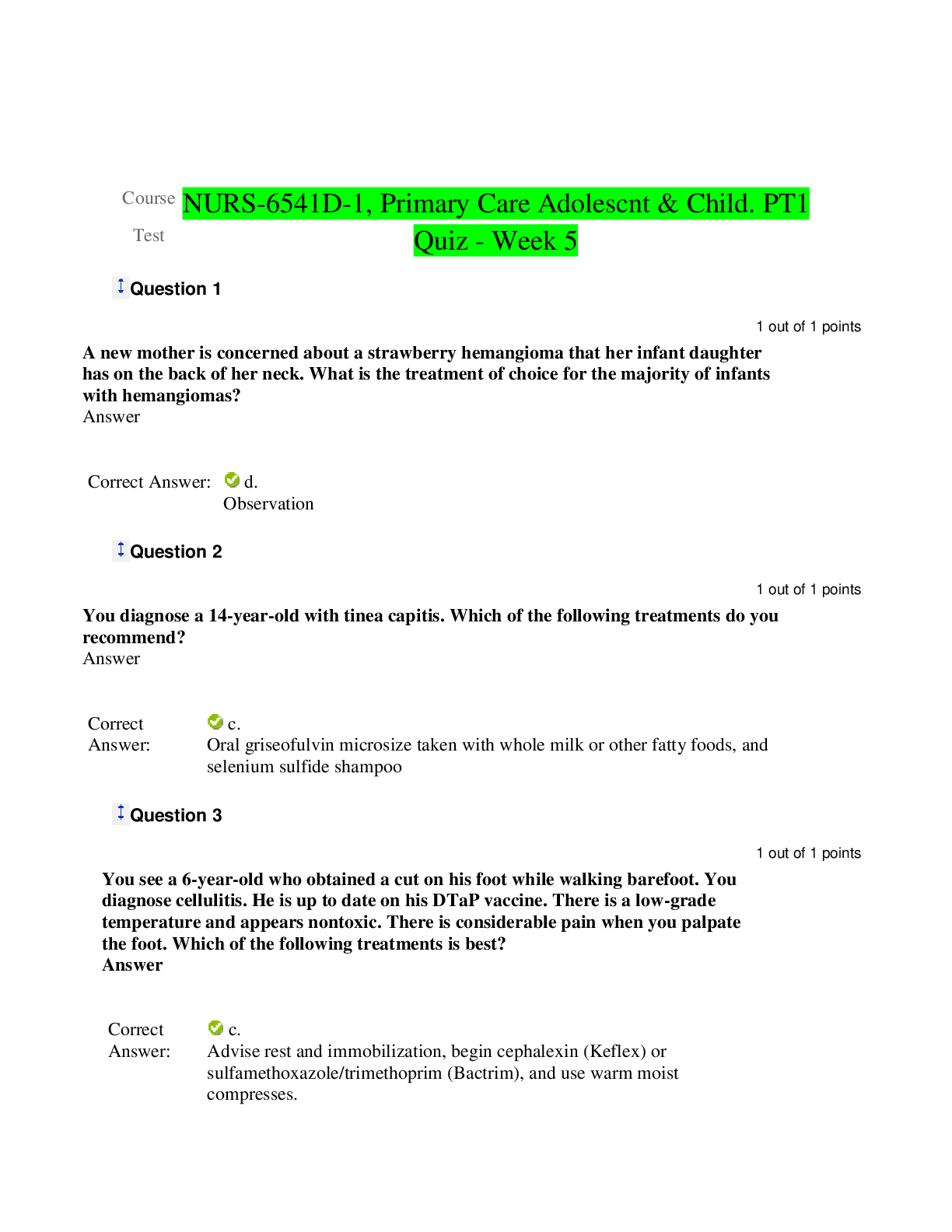


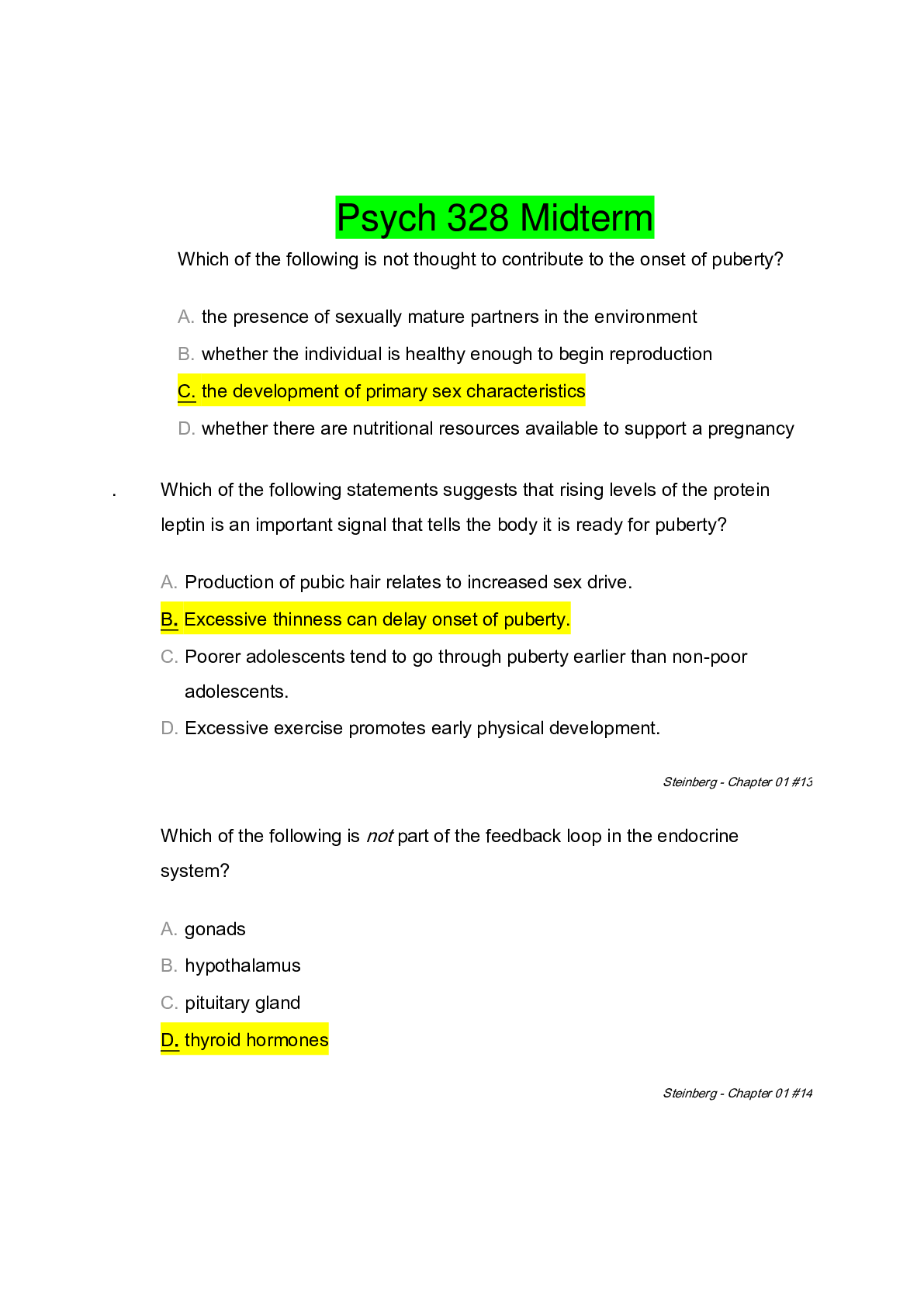


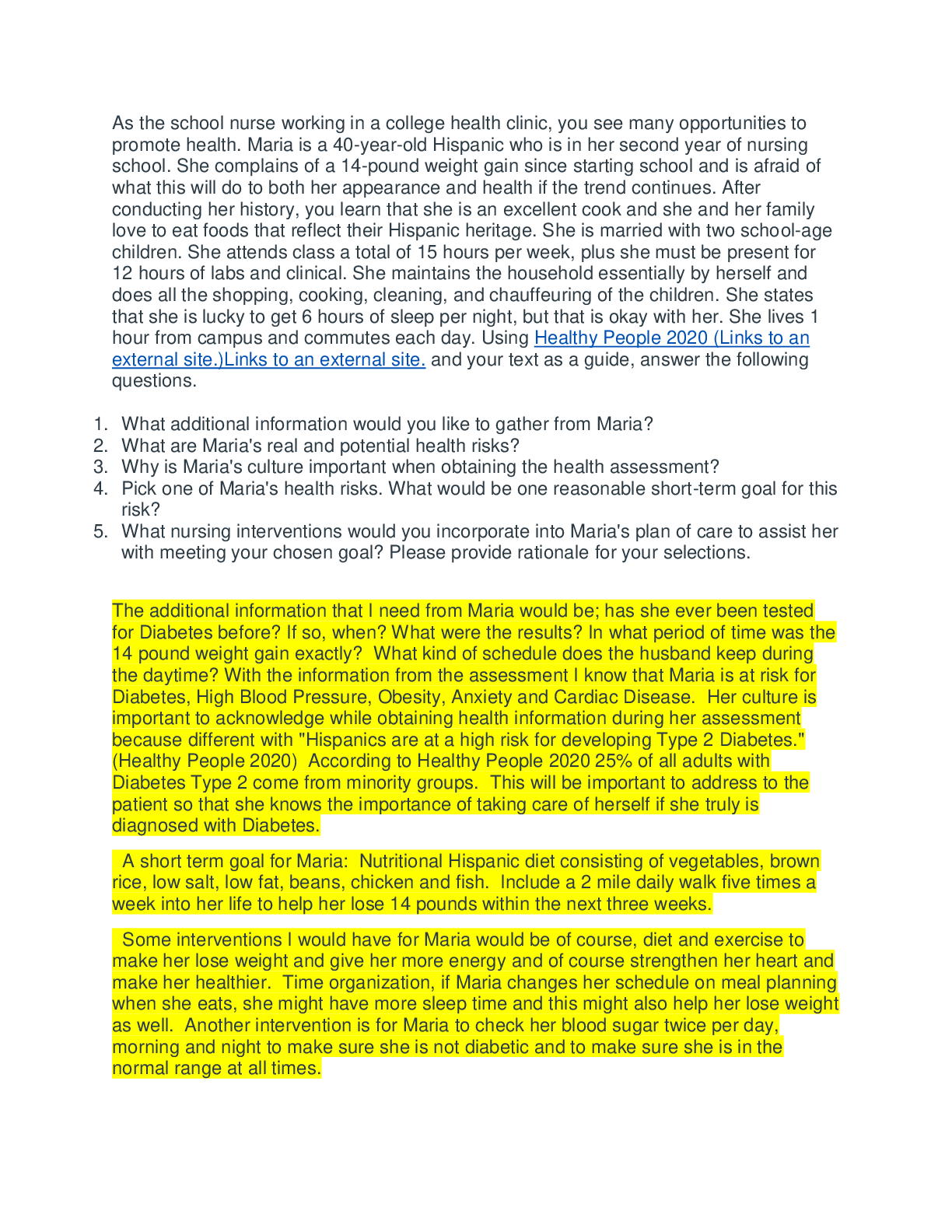
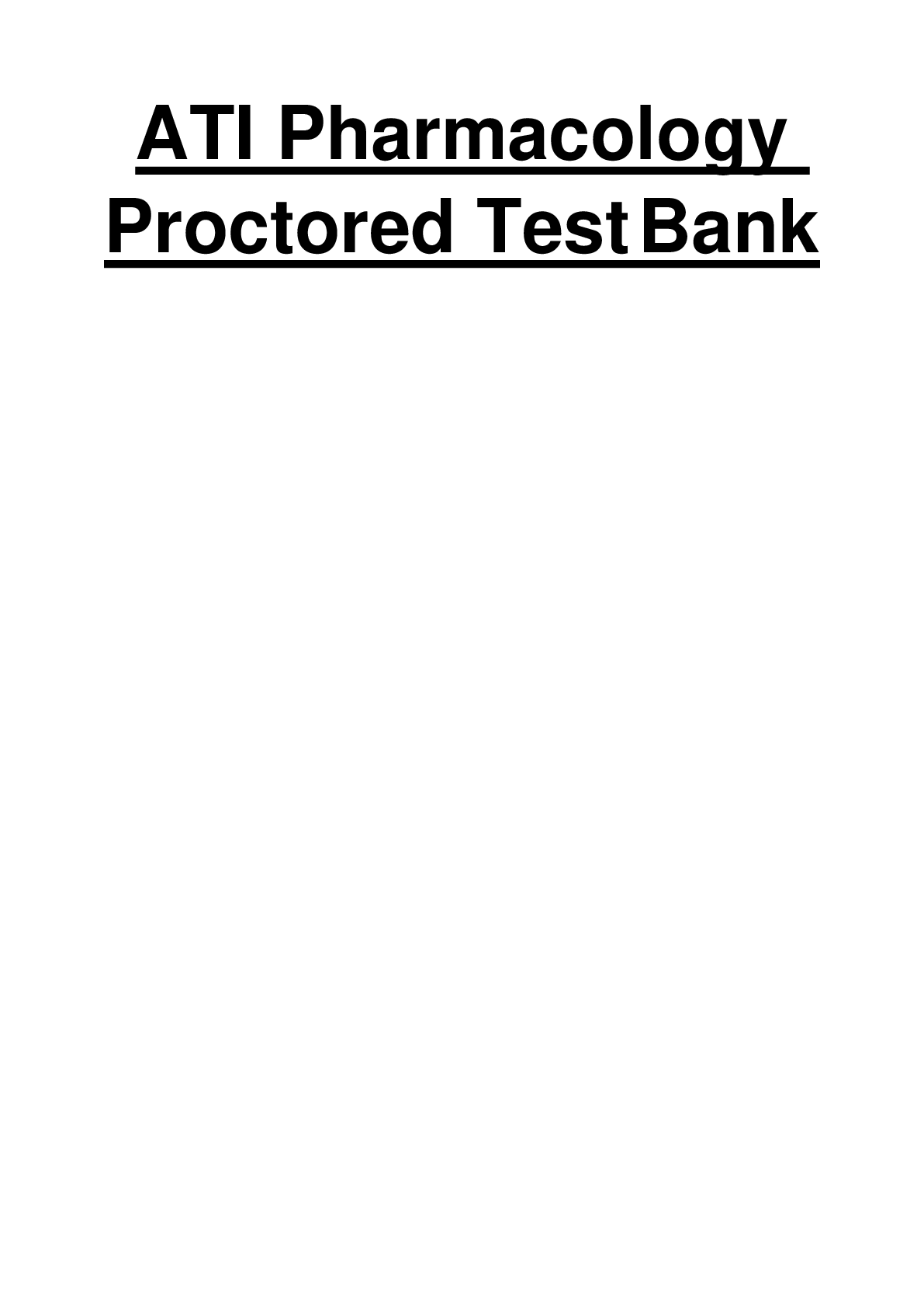
 Self-Assessment Examination (100 Questions With All Correct Answers) Complete solution.png)
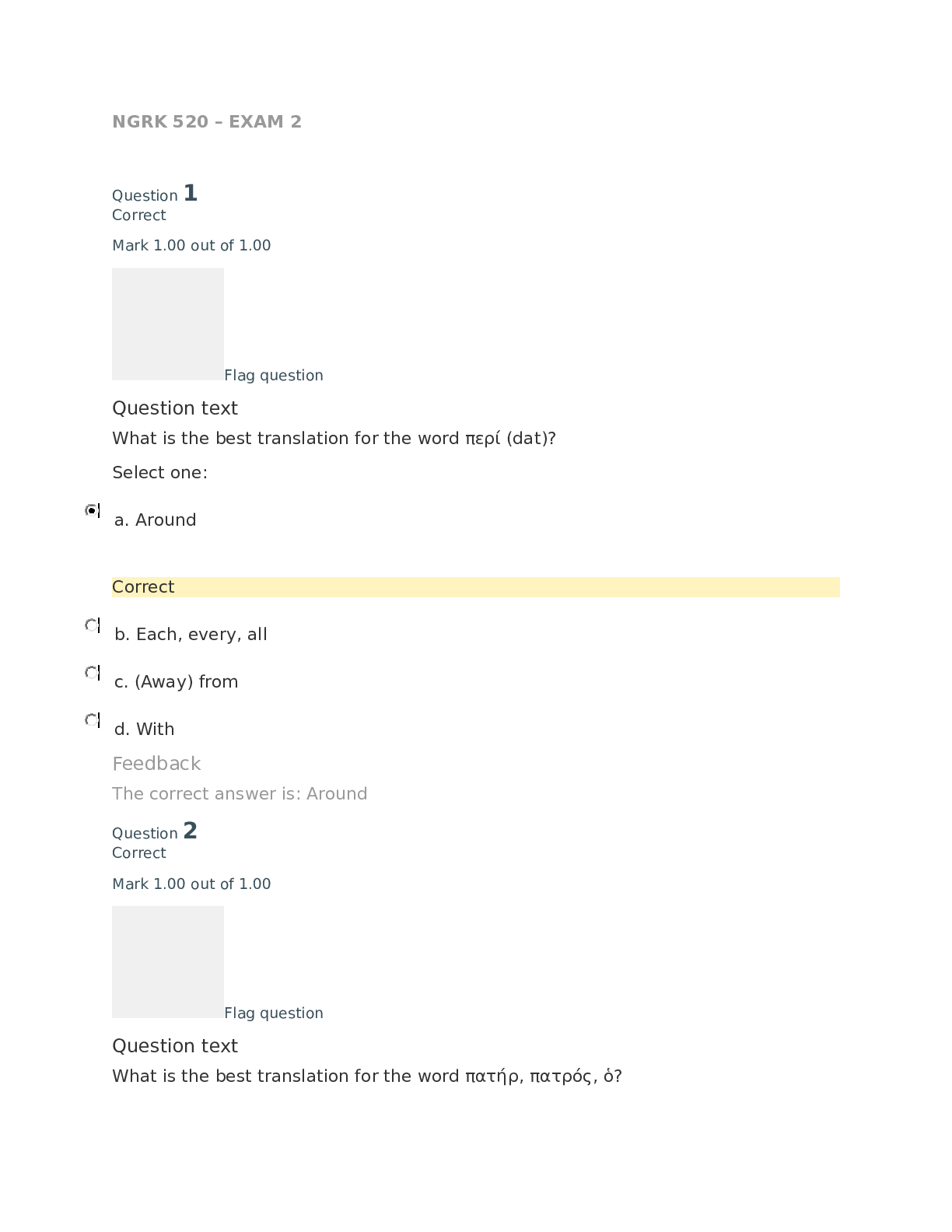
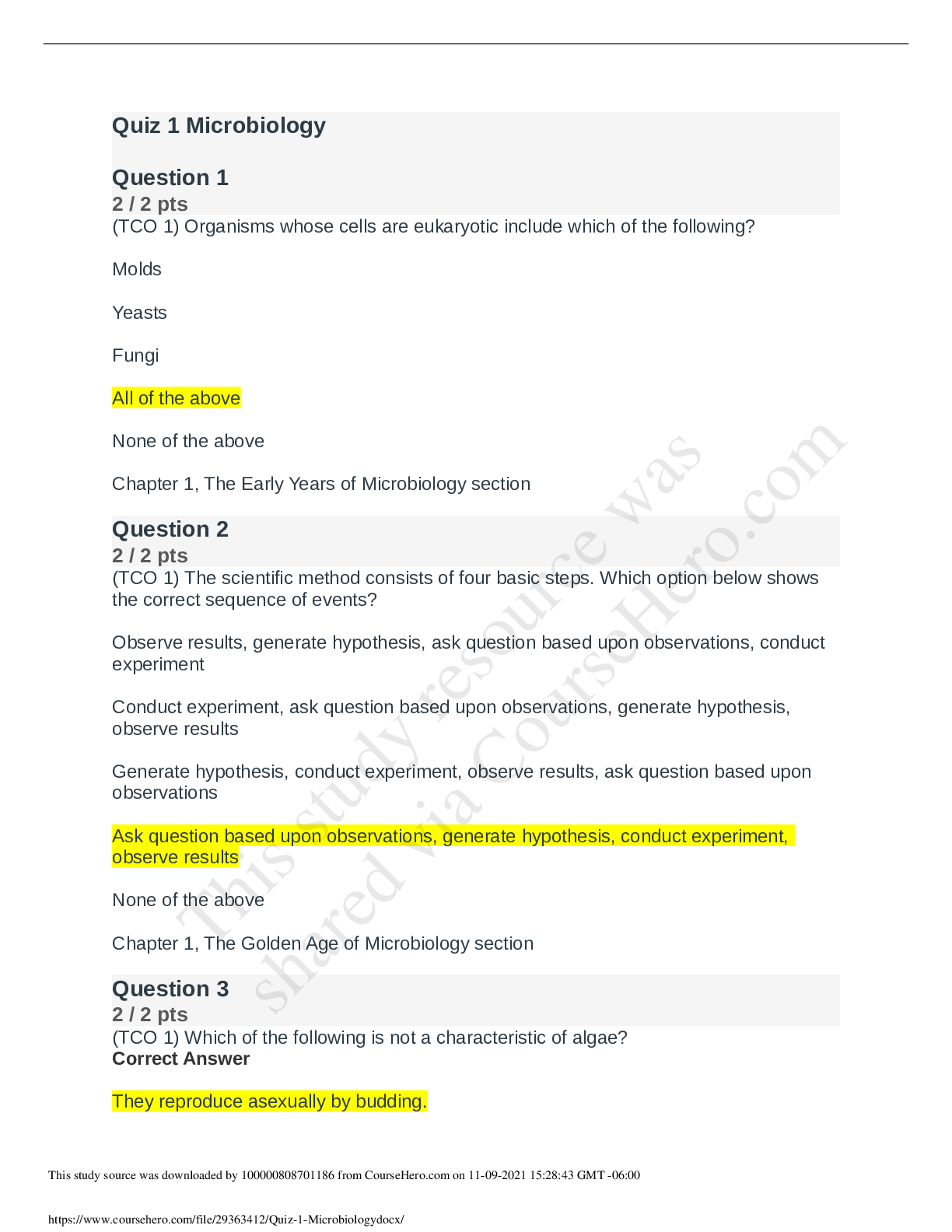
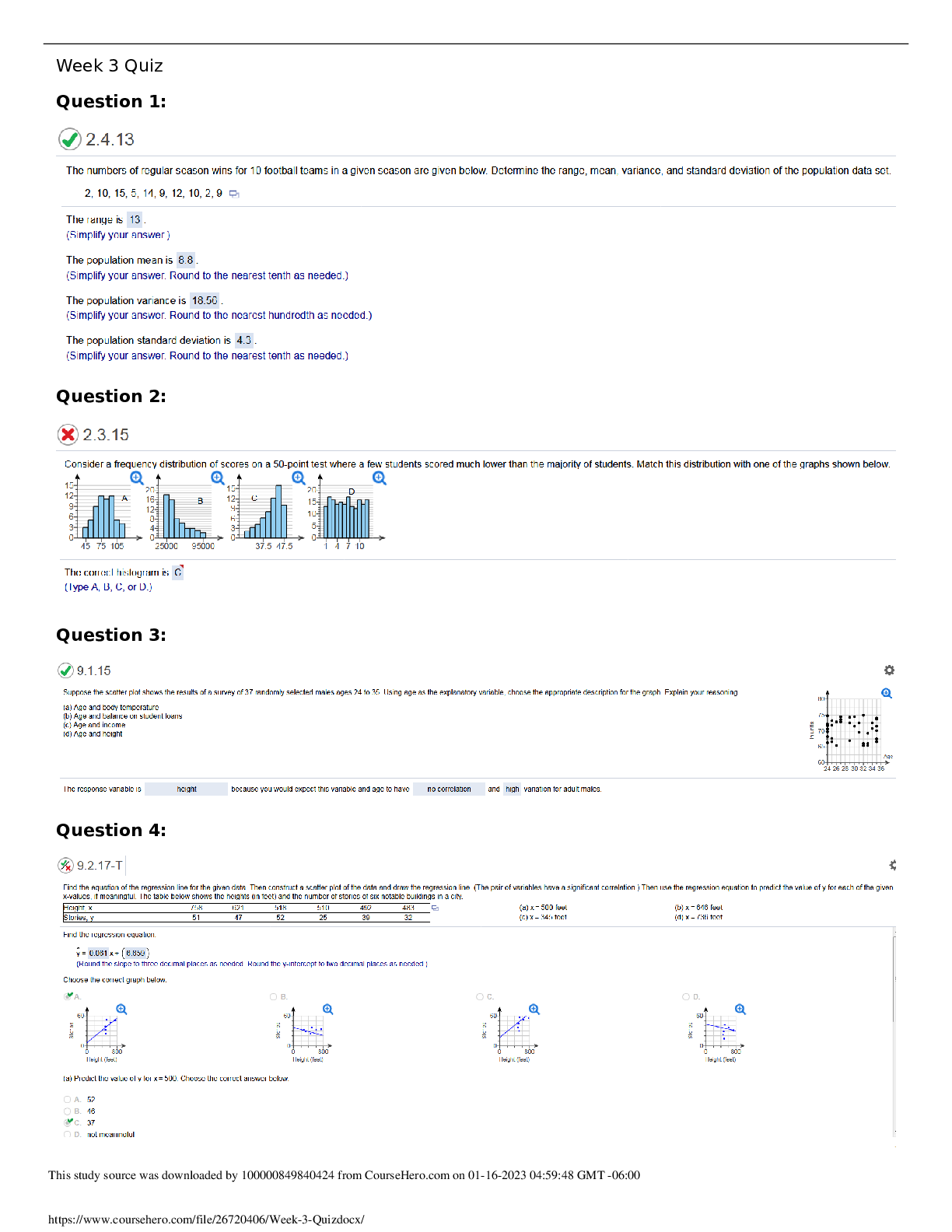
.png)
